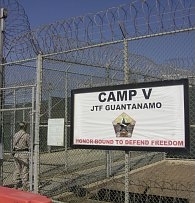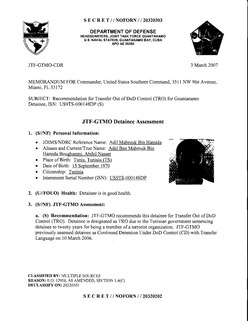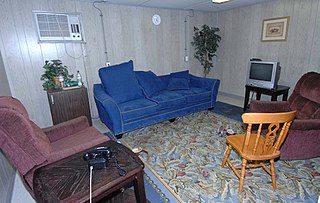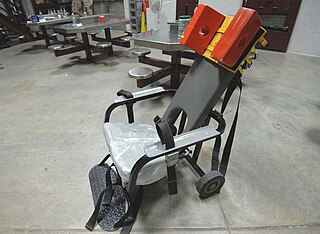
Camp Delta is a permanent American detainment camp at Guantanamo Bay that replaced the temporary facilities of Camp X-Ray. Its first facilities were built between 27 February and mid-April 2002 by Navy Seabees, Marine Engineers, and workers from Halliburton subsidiary Kellogg, Brown and Root. It is composed of detention camps 1 through 6, Camp Platinum, Camp Iguana, the Guantanamo psychiatric ward, Camp Echo and Camp No. The prisoners, referred to as detainees, have uncertain rights due to their location not on American soil. There are allegations of torture and abuse of prisoners.
The 2005 Quran desecration controversy began when Newsweek's April 30, 2005, issue contained a report asserting that United States prison guards or interrogators had deliberately damaged a copy of the Quran. A week later, The New Yorker reported the words of Pakistani politician Imran Khan: "This is what the U.S. is doing—desecrating the Koran." This incident caused upset in parts of the Muslim world.

Joint Task Force Guantanamo (JTF-GTMO) is a U.S. military joint task force based at Guantanamo Bay Naval Base, Guantánamo Bay, Cuba on the southeastern end of the base. JTF-GTMO falls under US Southern Command. Since January 2002 the command has operated the Guantanamo Bay detention camps Camp X-Ray and its successors Camp Delta, Camp V, and Camp Echo, where detained prisoners are held who have been captured in the war in Afghanistan and elsewhere since the September 11, 2001 attacks. From the command's founding in 2002 to early 2017, the detainee population has been reduced from 779 to 41. As of June 2021, the unit is under the command of U.S. Army Brigadier General Lance A. Okamura.

Shaker Aamer is a Saudi citizen who was held by the United States in the Guantanamo Bay detention camp in Cuba for more than thirteen years without charge.

Adnan Farhan Abdul Latif, also known as Allal Ab Aljallil Abd al Rahman, was a Yemeni citizen imprisoned at the U.S. military prison at Guantanamo Bay, Cuba, from January 2002 until his death in custody there, ruled a suicide.

The Guantanamo Bay detention camp is a United States military prison located within Guantanamo Bay Naval Base, also referred to as Guantánamo, GTMO, and "Gitmo", on the coast of Guantánamo Bay in Cuba. Of the 780 people detained there since January 2002 when the military prison first opened after the September 11, 2001 attacks, 731 have been transferred elsewhere, 39 remain there, and 9 have died while in custody.

Musab Omar Ali al Madoonee is a citizen of Yemen who was held in extrajudicial detention in the United States Guantanamo Bay detainment camps, in Cuba.

Adel Ben Mabrouk is a citizen of Tunisia who was held in extrajudicial detention at the United States' Guantanamo Bay detainment camps, in Cuba, from March 2002 to November 2009. Mabrouk had outstanding warrants in Italy, and shortly after his arrival in November 2009, Italian prosecutors laid charges against him.
The Parwan Detention Facility is Afghanistan's main military prison. Situated next to the Bagram Air Base in the Parwan Province of Afghanistan, the prison was built by the U.S. during the George W. Bush administration. The Parwan Detention Facility, which housed foreign and local combatants, was maintained by the Afghan National Army.
Inayatullah, born Hajji Nassim (1974–2011) was a citizen of Afghanistan who was arrested in 2007 and transferred that year to be held as an enemy combatant in the United States Guantanamo Bay detainment camps, in Cuba. His Guantanamo Internment Serial Number was 10028. Nassim was held in Guantanamo for 3 years, 8 months, and 22 days until his death by apparent suicide. The US claims he admitted being an al Qaeda leader, but Nassim denied this in numerous interrogation sessions. The US military claims he was headquartered in Zahedan, Iran. Nassim was the 19th captive to have been transferred to Guantanamo since September 6, 2006.
The frequent flyer program is a controversial technique used by the U.S. in the Guantanamo Bay detainment camps, in Cuba. Guards deprived detainees of sleep by moving them from one cell to another, multiple times a day, for days or weeks on end.

After the United States established the Guantanamo Bay detention camp at its naval base in Cuba, officials occasionally allowed Guantanamo captives' phone calls to their family. In 2008 the Joint Task Force Guantanamo that manages the camps developed rules regarding phone calls: all detainees who met certain conditions were allowed to make one call home per year.
Ahmed Zaid Salim Zuhair is a citizen of Saudi Arabia formerly held in extrajudicial detention in the United States's Guantanamo Bay detention camps, in Cuba.
Camp Seven is the most secure camp known within the Guantanamo Bay detention camps, in Cuba. Its existence was kept secret for the first two years of its use. It was constructed to hold the fourteen "high-value detainees" who had been held by the CIA, and were transferred to military custody on September 6, 2006.
Guantanamo Bay homicide accusations were made regarding the deaths of three prisoners on June 10, 2006 at the United States Guantanamo Bay detention camp for enemy combatants at its naval base in Cuba. Two of the men had been cleared by the military for release. The United States Department of Defense (DOD) claimed their deaths at the time as suicides, although their families and the Saudi government argued against the findings, and numerous journalists have raised questions then and since. The DOD undertook an investigation by the Naval Criminal Investigative Service, published in redacted form in 2008.

The Guantanamo Bay Hunger Strikes were a series of prisoner protests at the Guantanamo Bay detention camp. The first hunger strikes began in 2002 when the camp first opened, but the secrecy of the camp's operations prevented news of those strikes from reaching the public. The first widely reported hunger strikes occurred in 2005.

Colonel Donnie Thomas was the commander of Joint Task Force Guantanamo's Joint Detention Group from February 2010 to June 2012.

Abdel Malik Ahmed Abdel Wahab al Rahabi is a citizen of Yemen who was held in extrajudicial detention by the United States from December 2001 to June 22, 2016. He was one of the first twenty captives transferred to the Guantanamo Bay detention camps, in Cuba, on January 11, 2002, and was held there until he was transferred to Montenegro, which granted him political asylum.










